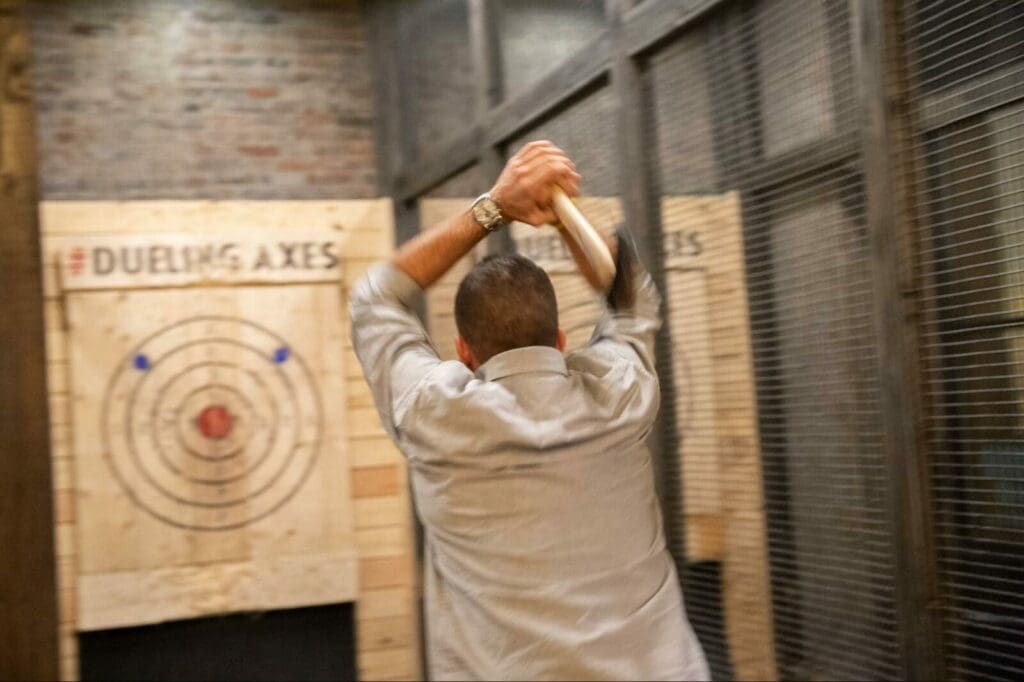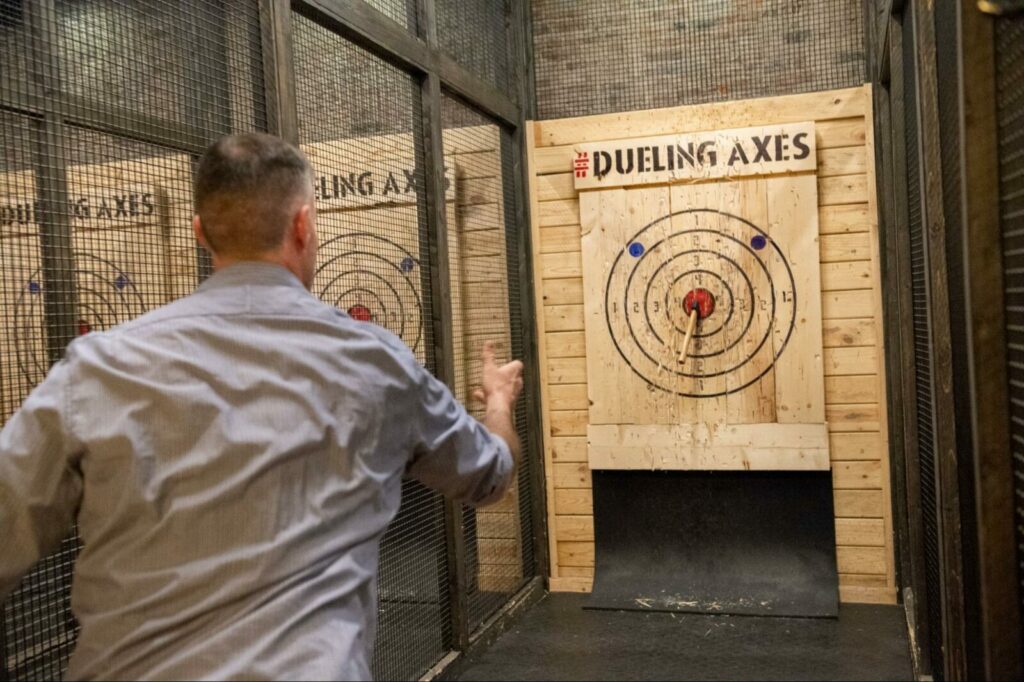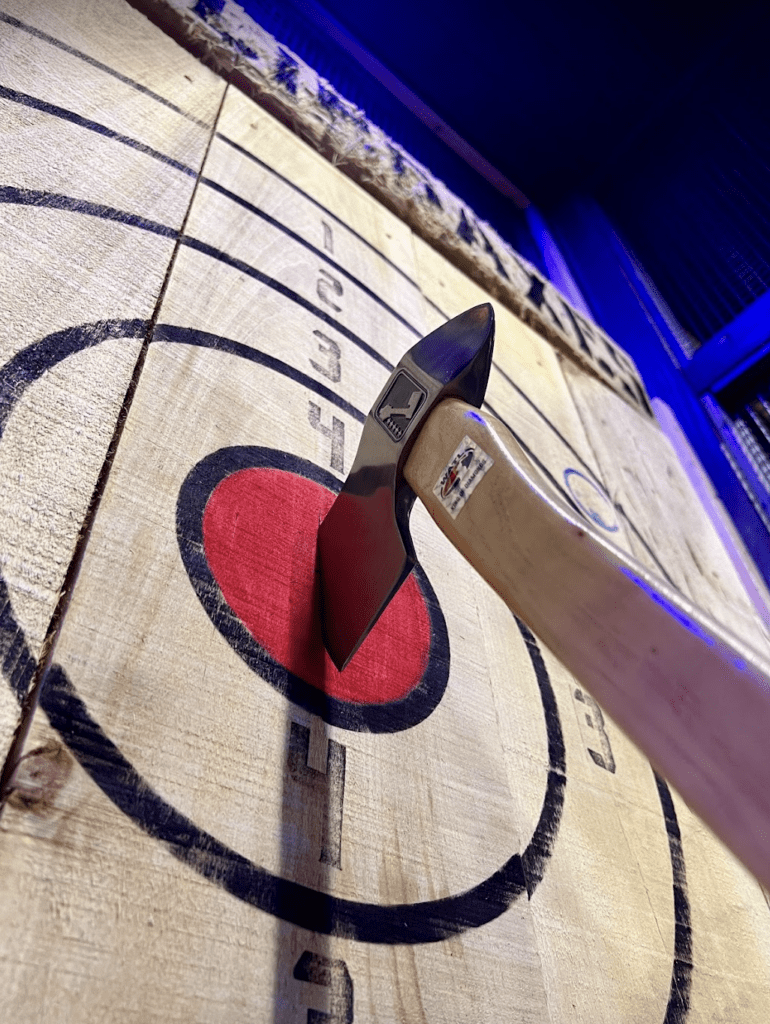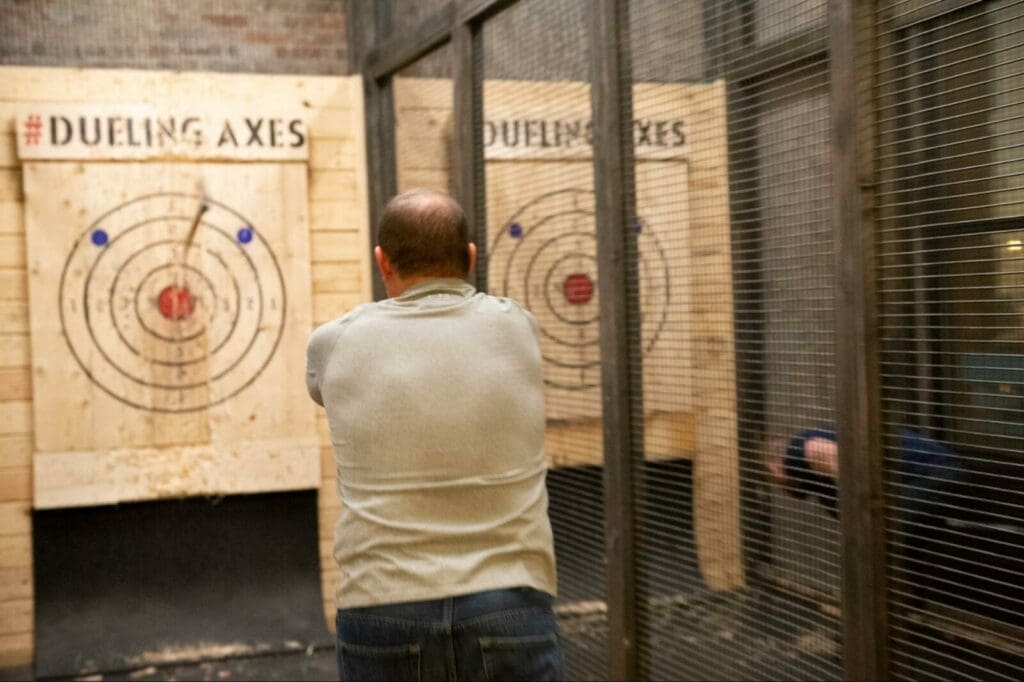
Step into the exciting world of axe throwing, where the age-old art of lumberjacks seamlessly merges with the thirst for thrilling experiences. But don’t be fooled, this captivating sport goes far beyond the surface. Beyond the raw excitement lies a realm of techniques and scientific principles waiting to be unraveled.
Not all throws are created equal; to hit that perfect bullseye demands more than just raw strength. It calls for tact, concentration, and, most importantly, an understanding of the science that governs each and every throw. So, if you’re eager to take your axe throwing game to new heights, read on as we delve into the fascinating science behind it all! From the critical role of velocity in propelling the axe forward to the art of controlling its rotation and finding that elusive release angle, we’ll explore the essential elements that contribute to a perfect throw. But that’s not all; we’ll also equip you with practical advice to fine-tune your technique, ensuring you hit your target with confidence and precision.
Back To Basics
First time axe thrower? You may want to brush up on the nitty gritty axe throwing tips for beginners. Otherwise, keep reading for a full breakdown on the science behind the perfect axe throwing technique!

The Components of A Perfect Axe Throw
Axes have their own unique ways of being thrown, depending on how they’re designed. That’s why at Dueling Axes, we’ve picked a standard type of axe, which we call our “house axe.” This way, all our coaches are familiar with how this axe works with our setup, and they can give you even better coaching!
Factors like how long the handle is and where the weight is in the axe head makes a big difference in how the axe moves through the air. For example, if the handle is longer, it takes more time for the axe to spin around. This is why in competitions, “Hatchet” event throwers shoot their shot from about 12 feet away, and for the “Big Axe” event, it’s about 17 feet.
Science shows that thinner blades are awesome for throwing because they have less surface area and stick into the target more easily compared to thicker blades that are intended for spliting and pushing wood apart. You want the blade to be sharp so it doesn’t cuts into the target board like butter. Handles that are flatter are easier to hold on to compared to round ones. This gives you more control when you throw and let go of the axe!
Balance and Weight Distribution Techniques
Achieving balance brings steady consistency to axe throwing. In this sport, it’s important to rely on the axe head’s weight for rotation instead of using a flicking motion with your wrist, which can vary from throw to throw. Releasing the axe with a straight wrist ensures the dependable rotation from the axe head’s weight. A well-balanced axe keeps your throws consistent and lets you hold the handle just right, so you don’t have to adjust your grip for the correct spin.
A balanced axe matters because it helps you throw consistently, without needing to change your stance or aim during your throw to fix how it flies. Axes that aren’t balanced tend to wobble in the air, making your aim less accurate. When you use an axe with good balance, you can focus on improving your technique instead of trying to make up for a wobbly tool. We’ll circle back to this several times throughout the article. When throwing with us, find comfort in knowing our team checks every axe to make sure it throws smoothly every time, no matter how much experience you have.
How to Keep Your Axe Steady Mid-Air
Imagine a gyroscope, a device that stays stable in both vertical and horizontal directions. When a gyroscope is balanced, it remains steady on all axes. This same idea applies to an axe. If the weight isn’t distributed evenly, the axe wobbles and loses its controlled flight.
As you’ve learned, differences in handle length and weight affect the axe’s flight. A shorter and lighter handle leads to faster rotations, while a longer and heavier one provides better control over rotation.
Finding The Right Grip and Stance
Struggling to hit that bullseye? Believe it or not, you can make a few adjustments in your grip and stance to make it happen. Let’s break it down:
In terms of stance, start by positioning your non-dominant foot slightly ahead of your dominant one, both with a gentle knee bend (like an athletic stance). Make sure your shoulders and chest squarely face the target. Typically, you’ll find yourself aligned with the target board as you aim for the bullseye.
Holding the axe can be done in two primary ways: with both hands or just one. Keep a firm grip without causing your knuckles to turn white. For a double-handed grip, begin by grasping the axe’s base with your dominant hand, then overlay your non-dominant hand on top of the first (similar to gripping a pistol). Extend your arms straight ahead, aligning your elbows and wrists, and position the axe head at eye level – this is your starting position. If you’re going for a single-handed throw, hold the axe’s base with your dominant hand, extend your arm straight forward, align your elbow and wrist, and keep the axe head at eye level. Your other arm can remain comfortably at your side.
Maintain a balanced and steady stance to avoid unintended shifts that could impact your aim during the throw. Find the right distance from the target, striking a balance between avoiding over-rotation from standing too far and preventing under rotation by standing too close. Your stance as a thrower should be moderately wide – enough for stability but not excessively so.
When you step forward to throw, let your non-dominant foot take the lead and shift your weight as you release, directing your momentum into the axe. Hold the axe with your dominant hand near the base of the handle. For a two-handed throw, encompass your dominant hand with the other. And there you have it – the right way to stand to achieve a bullseye-worthy throw. All that’s left is to make sure you’re holding the axe correctly to have total control!
Mastering Your Axe Grip for Precision Control
Not everyone is a natural at mastering their axe grip, and that’s perfectly okay! The way you hold your axe has a profound impact on your ability to precisely control its path.
When an axe starts to wobble in mid-air, it’s often due to a loose wrist. Finding the right balance is crucial. Gripping the axe too tightly can result in a delayed release and a low throw. Conversely, holding it too softly might lead to an early release, causing your throw to soar high without the necessary rotational force. Keeping the axe straight during your throw translates into a direct trajectory. However, tilting it to the left or right will cause it to veer off in the corresponding direction, missing the target.
Resist the urge to flick your wrist as you release the axe – this can generate excessive rotation. Opt for a handle grip without a thumbs-up position. Maintain a grip that’s secure but not overly constricting, preventing any hindrance in releasing the axe or it getting stuck to your palm. Keeping your wrist straight and your hand aligned ensures a clean and precise release, resulting in a straight trajectory for the axe. Your control starts with your grip, so make it count!
Understanding Axe Flight: Unveiling Aerodynamic Principles
Exploring the fascinating world of axe aerodynamics sheds light on the dynamic flight of this tool. To dive deeper into these principles, check out this comprehensive resource that explains the science behind it.
- Drag and Resistance: The shape of an axe’s components plays a pivotal role in the level of drag experienced during a throw. Axes with minimal surface area facing the oncoming air encounter reduced resistance as they fly.
- Lift: Lift serves as the counterforce to air resistance, impacting the axe’s trajectory.
Navigating Axe Dynamics: Factors Influencing Movement through the Air
One of the captivating aspects of axe throwing is its accessibility. This skill doesn’t hinge on extraordinary strength. The axe’s weight, just over 1.25 pounds, isn’t formidable. The key lies in the thrower’s ability to propel it from the throwing area to the target with ample force. The axe head’s weight governs its rotation in flight. However, it’s important to find the right balance. Overthrowing can lead to excessive rotation, while under-throwing might result in insufficient rotation. As we mentioned before, loose wrists during the throw can lead to wobbling, and grip tightness, whether too loose or too tight, can similarly affect the outcome.
Don’t be afraid to ask your axe throwing coach for on-the-spot pointers if you need them – we were all beginners once!
Deciphering Rotational Dynamics: Unveiling Axe Spin in Flight
When an axe takes flight, its journey is guided by a captivating interplay of forces. This movement involves an intricate rotation centered around the axe’s gravitational midpoint, positioned near the head. This rotation, when harmonized with the force and inertia transferred during the throw, engenders angular momentum. This momentum fuels the axe’s spin, sustaining it until its trajectory is impeded by the target’s impact.
Impact of Axe Spin on Stability and Precision
You know when you see a bike stay upright while moving, but it falls over when it stops? Well, a similar thing happens to the axe. As it moves through the air, the spinning makes it stick to a certain path, just like the bike. This gyroscopic effect helps the axe stay steady and not veer off course.
Crafting a Flawless Release
Releasing an axe in mid-throw might sound simple, but there’s a lot more to it!
Starting from the stance we covered earlier, raise the axe just a bit behind your head, with slightly bent elbows, and hold the axe handle so it forms a 90-degree angle with your forearms. Make sure your shoulders and chest squarely face the target. As you initiate the throw, swing your arms forward in a curved motion, putting some force into it. While maintaining that 90-degree angle, release the axe when your hands come back to about eye level, with your forearms straight ahead and wrists locked. This will result in the axe flying straight ahead, end-over-end.
A word of caution: Don’t twist your body during the throw, and in case of a one-handed throw, don’t let your throwing arm cross your body. These mistakes could make the axe go at an angle and miss the bullseye. Releasing too early makes the throw go high, and releasing too late makes it go low.
For a stable release with minimal arm shake, focus your eyes on the target as you hold the axe over your head (or shoulder for one-handed throws). As you bring your arms and the axe down, release it when the bottom of the axe head reaches eye level. This clean release helps the axe fly steady without wobbling. Remember, the force you give the axe initially, the angle of release, how it rotates, and gravity all work together to shape the axe’s path.
Timing and Angle: The Secrets to Hitting the Bullseye (Plus, a Throwing Tutorial Video)
The key here is to release the axe at eye level, so it heads straight towards the bullseye. For a clearer visual, watch our throwing tutorial video included in this section. It provides additional insights to help you nail that bullseye shot!
May the Force (and Velocity) be With You
In the real world, a successful throw depends much more on factors like the distance, the axe’s weight, and the handle length than just tossing it with extra oomph. Of course, if there’s nothing in the way, adding more force will make the axe travel farther. However, when you use the correct technique we covered earlier, even if you throw with a ton of power, the axe’s rotation should remain consistent, and it should hit the target in a way that satisfyingly sinks into the target.
Now, let’s talk about the potential pitfalls – the risk of using too much force lies in applying it with improper technique. This can lead to an axe break or an unintended bounce off the target. As you throw, the momentum from your body is transferred to the axe. This momentum won’t stop until it hits the target, unless you’re standing way too far away. But the heart of axe throwing isn’t all about muscle power; it’s more about the angle of your throw.
If you toss the axe at too low of an angle (below eye level), two things can happen:
- It won’t align with the bullseye.
- It won’t get enough rotations to reach the board – it might just hit the floor or the bottom of the board.
The angle is where the magic lies in axe throwing, even more than how strong your throw is!
The Intricate Dance of Axe Angles and Flight Paths
Ever wondered how the way you angle and throw the axe, as well as its path through the air, affects your aim? You may be surprised… We often compare the art of axe throwing and hitting your target to a game of golf. Success hinges on technique and maintaining consistency. This consistency allows you to throw from the same spot, with the same axe, in the same way every time – ensuring you hit your target right where you aim. The technique involves using the X and Y axes while avoiding the Z axis.
TL:DR; Don’t tilt the axe to the left or right or spin it sideways when throwing.
The secret lies in releasing the axe at eye level. This rotation is what makes it land neatly parallel to the board, right in front of you. If your angle is too high or low, the number of rotations changes, leading the axe’s trajectory to end without aligning perfectly with the board.
Factors Influencing Aiming Precision: Distance, Wind, and Target Size
Distance plays a big role. As previously mentioned, the axe usually completes one rotation before hitting the target. If it doesn’t, we often advise guests to step back slightly. This provides more distance and time for the axe to rotate fully before hitting. The impact of distance on your throw involves the increased time gravity has to affect the horizontal trajectory – your aim.
In outdoor throws or on a mobile axe trailer, wind conditions come into play. Wind can lead to unstable footing, or it might make your axe veer to the right or left instead of flying straight ahead. Due to the relatively short distance typically thrown in recreational (and competitive) axe thorwing, this isn’t too big of a concern, but worth mentioning. Remember, mastering the bullseye is a combination of technique and understanding these nuanced variables!
Exploring Axe Throwing Styles: Diverse Techniques Embraced by Enthusiasts
For formal competition, the common approach is overhand/above the head throwing. However, there’s a world of trick shots out there that have evolved over time. While those aren’t part of our venue’s practice, let’s focus on the notable styles that are:
- One-Handed: As the name suggests, this involves holding the axe with one hand and throwing it from over the thrower’s shoulder.
- Two-Handed: Here, the axe is gripped with both hands and thrown from over the thrower’s head. This style provides added stability and control.
- Underhanded: In this technique, the axe is held with one hand, with the blade facing backward. It’s then released from the thrower’s chest height. This style offers a unique twist on the traditional throw.
Each style brings its own flavor to the art of axe throwing, and enthusiasts often find joy in experimenting with various techniques!
Transform Your New Axe Throwing Insight into Bullseye Excellence
In the world of axe throwing, excitement and technique collide. Beyond the thrill lies a world of methods and science that shape every throw. It’s not just about power; it’s about balance, precision, and physics. From axe weight to grip and release, you now know how each element contributes to the perfect throw!
As you step up to the line, remember that axe throwing is an art informed by science. Let the knowledge guide your aim, and let your technique bring the thrill. Here’s to hitting the bullseye, armed with both skill and science.
Ready to put your newfound knowledge to the test? Book your online reservation now at Dueling Axes’ Columbus or New Albany lounges. Happy throwing, and may your bullseyes be plenty!








